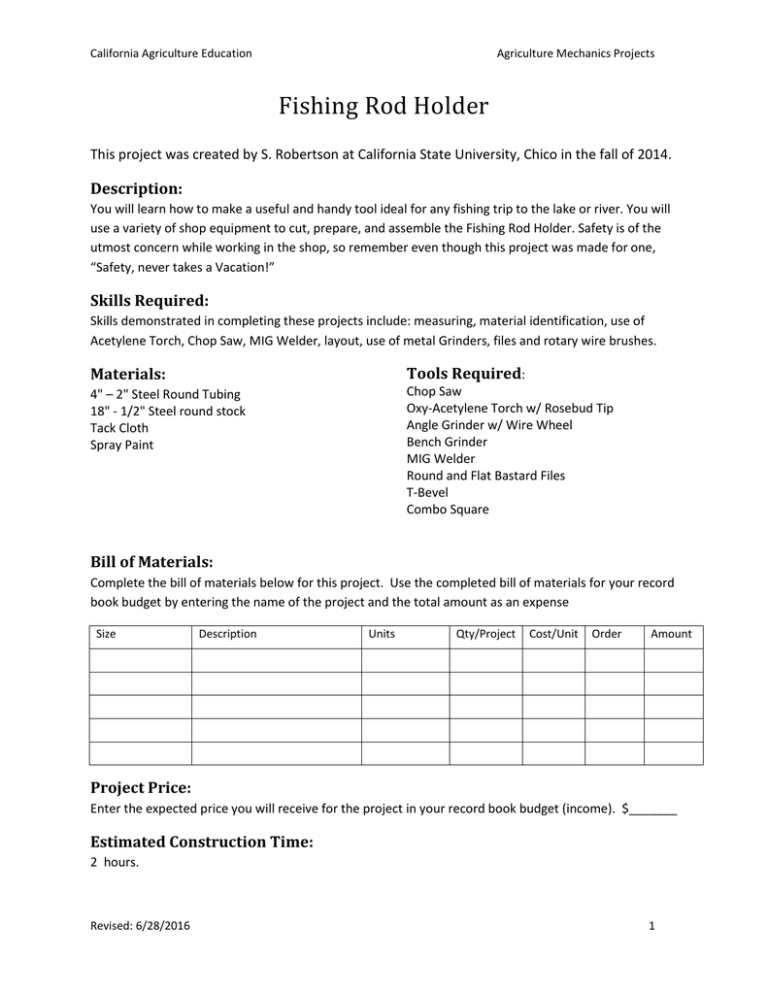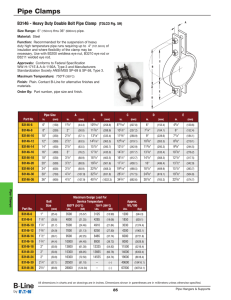Fishing Rod Holder Description:
advertisement

California Agriculture Education Agriculture Mechanics Projects Fishing Rod Holder This project was created by S. Robertson at California State University, Chico in the fall of 2014. Description: You will learn how to make a useful and handy tool ideal for any fishing trip to the lake or river. You will use a variety of shop equipment to cut, prepare, and assemble the Fishing Rod Holder. Safety is of the utmost concern while working in the shop, so remember even though this project was made for one, “Safety, never takes a Vacation!” Skills Required: Skills demonstrated in completing these projects include: measuring, material identification, use of Acetylene Torch, Chop Saw, MIG Welder, layout, use of metal Grinders, files and rotary wire brushes. Materials: Tools Required: 4" – 2" Steel Round Tubing 18" - 1/2" Steel round stock Tack Cloth Spray Paint Chop Saw Oxy-Acetylene Torch w/ Rosebud Tip Angle Grinder w/ Wire Wheel Bench Grinder MIG Welder Round and Flat Bastard Files T-Bevel Combo Square Bill of Materials: Complete the bill of materials below for this project. Use the completed bill of materials for your record book budget by entering the name of the project and the total amount as an expense Size Description Units Qty/Project Cost/Unit Order Amount Project Price: Enter the expected price you will receive for the project in your record book budget (income). $_______ Estimated Construction Time: 2 hours. Revised: 6/28/2016 1 California Agriculture Education Agriculture Mechanics Projects Directions: Part 1 Directions 1. Using a steel tape measure and a piece of soapstone measure 4” on your piece of 2” O.D. tubing and make a mark. 2. Measure and mark 18” on a piece of 0.5” round stock. 3. Using the chop saw cut the measured 4” length of the 2” O.D. pipe. 4. Using the chop saw cut the 18” length of 0.5” round stock. a. It is important to wear safety glasses as well as the face guard provided. 5. With a Flat Bastard file and a round file remove any sharp edges that may have been created when making your cuts with the chop saw. Do this on both pieces you have cut. 6. Using the bench grinder, grind the bottom point on the 18” round stock into a point. a. This will be the end that gets pushed into the ground. 7. Using a steel tape measure and a piece of soapstone measure 3.5” down from the top of your round stock (opposite of your pointed end). Make a mark. a. This is where the spike will be bent. 8. Securely clamp the round stock spike in a bench vise. The mark you just made (3.5”) should be just above the vise. 9. Grab a bevel gauge and set it at a 45 10. Using a rosebud tip on the Oxy-Acetylene torch heat the round stock above the vise. Heat the piece to a cherry red before bending. 11. Using a short piece of 1” diameter pipe, slip the one-inch pipe the top of the spike in the vise and use it to safely apply leverage on the piece, bending it to a 45 angle. 12. Grab the bevel gauge you already set at 45 to ensure the bend is accurate. a. If the bend is not at 45 , the piece can be reheated and bent to the proper angle. 13. Allow the piece to cool. 14. Next you will move to the welding portion of the project. 15. Get approval from instructor before moving on. Part 2 Directions (Welding) 16. Using a grinder with a wire wheel attachment, prep the spike and the pipe sections by cleaning of any rust, paint, dirt, or impurities from the steel. 17. Using a combo square, scribe a centerline down the center of the pipe. a. This will make it easier to line up the spike onto the pipe in a straight line. 18. Using a tape measure, measure down 1” from the end on the pipe along the scribed line. 19. Clamp the spike in place. 20. Using a spring clamp, clamp the pipe to the bent spike section along the center scribe line. a. Be sure to set the spike back to the 1” mark on the pipe. 21. With the pieces firmly clamped, weld one side of the pipe to the spike. 22. Let the piece cool. 23. Repeat this step for the opposite side of the pipe. 24. Let the piece cool. 25. Using a wire brush, clean the welds. a. A grinder can be used to smooth welds if necessary. 26. Once finished, and project is completely cooled, take project to instructor for inspection. Revised: 6/28/2016 2 California Agriculture Education Agriculture Mechanics Projects Part 3 Directions (Finishing) 27. 28. 29. 30. 31. 32. Wipe the project clean with a piece of tack cloth. Select a high quality, outdoor exposure spray paint. Choose an area with good ventilation, away from flames and sparks. Lay down a cloth or tarp to prevent a paint mess. Hang the project in mid air with wire through pipe section. Read and follow the directions on the spray paint can. Several light coats often provides the best results. Photo/Drawing: Revised: 6/28/2016 3 California Agriculture Education Agriculture Mechanics Projects Construction Log: Complete the log below making an entry every day you work on the project. Transfer the logged hours to your record book journal for this SAE enterprise. Date Tasks Completed Skills Used/Learned Hours Actual Price Received: Enter the actual price you received for the project in your record book journal as income. $_________ Revised: 6/28/2016 4 California Agriculture Education Agriculture Mechanics Projects Project Portfolio: Complete a portfolio for the project that includes: A description of the project and the skills you learned building the project. Include the hours spent on the project and the income (if sold). Use the construction log to complete this narrative. Write in complete sentences. The Bill of Materials The project plan 2-8 photos documenting the project at various stages of construction. Revised: 6/28/2016 5



